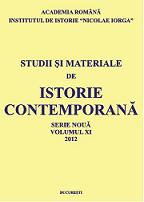Uniunea Artiştilor Plastici şi ideologizarea artei în România după
cel de-al doilea război mondial
The Union of Plastic Artists and the ideologizing of art in Romania
after World War II
Author(s): Paul NistorSubject(s): History
Published by: Institutul de Istorie Nicolae Iorga
Keywords: Art; Communism; Cold War; Communist Romania; Socialist Realism.
Summary/Abstract: The mechanisms through which art was ideologized in Romania were created following Soviet models, but they were applied under the initiative and control of the Romanian Communist Party. During the 1950s, not much was preserved of the tradition of Romanian art. A coherent set of norms, commissions, current practices and organizational entities were constituted specifically for directing the entire art towards socialist realism, and for changing the perceptions of the artists. As far as large exhibitions were concerned, they implied imposed themes, especially with a political and social focus. The works were coordinated by the so-called Guidance committees, which rectified the aesthetic deviations from the rigid rules of the Communist East. Grand conferences were organized throughout the country in order to promote the soviet artistic models, as well as the creative act related to the masses, which reflected the “revolutionary” transformations in the country. The magazines published reference articles for ideological and artistic guidance. The Union of Plastic Artists, the only form of professional association of painters, took over the task of “education” and control of the free minds of the artists. Through meetings held with an oppressive precision and through setting stereotypical political programs within the U.P.A groups, the ideology was connected to art, being assigned the main part. The effect of this strategy, which infested the artistic world with the Marxist- Leninist doctrine, was especially obvious in the artistic works and events. The exhibitions displayed works dedicated to the Romanian Communist Party leaders, to Romanian-Russian friendship, to the agrarian and industrial development. But, using the clever “weapon” of art, the images of democracy, of the West and of the national bourgeoisie were attacked, all these being made guilty of a problematic past, or of a tensed present. Among these display of forces there were also transgressions, avoidance of the rules, resistance to the brutal constraints and impositions. Through passivity and non-participation the artists avoided getting in line with the political ideals of the new regime. Many times the plans for applying the ideology to art looked good only on paper, as they confronted an indifferent reality and with the free human spirit, which manifested disinterest towards the new aesthetic-political doctrines.
Journal: Studii şi materiale de istorie contemporană (SMIC)
- Issue Year: 2012
- Issue No: 1
- Page Range: 110-125
- Page Count: 16
- Language: Romanian
- Content File-PDF

